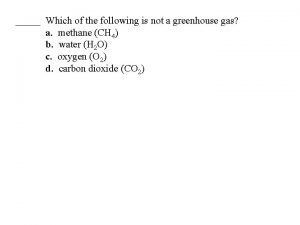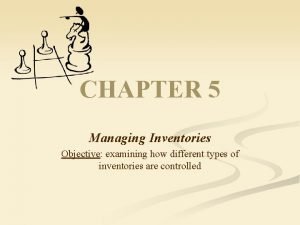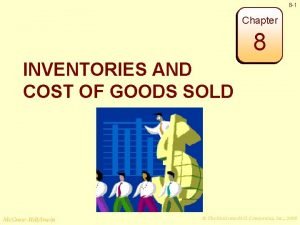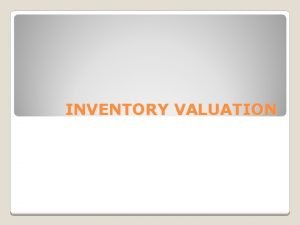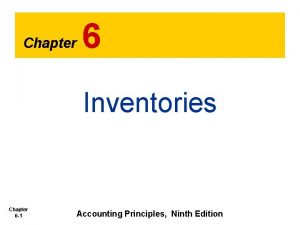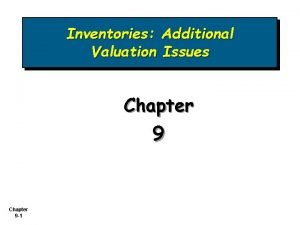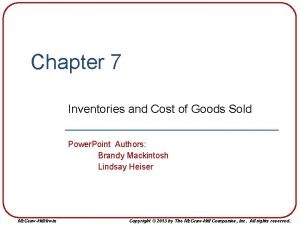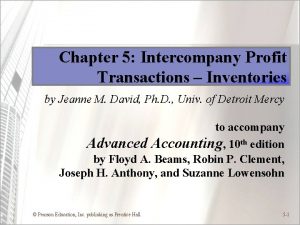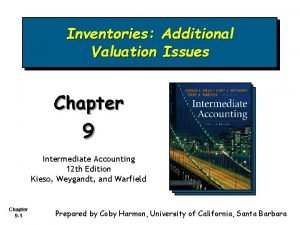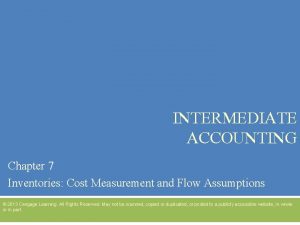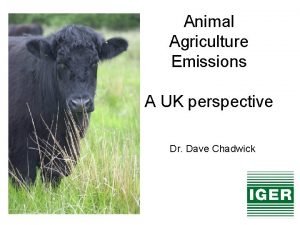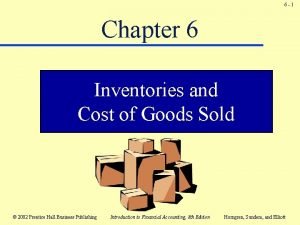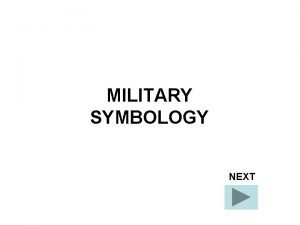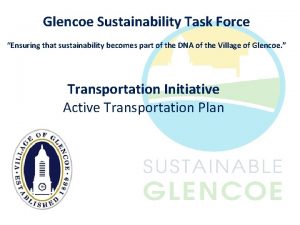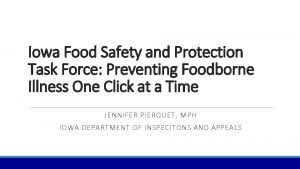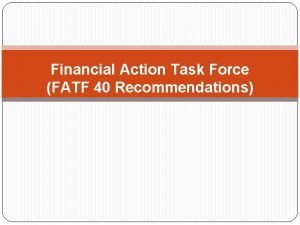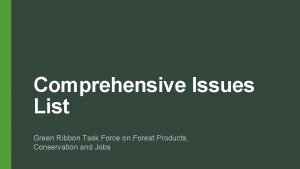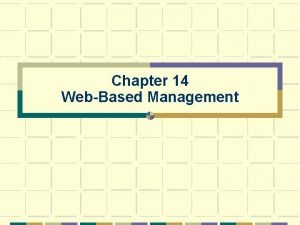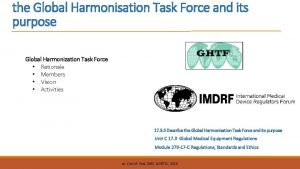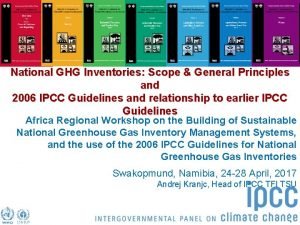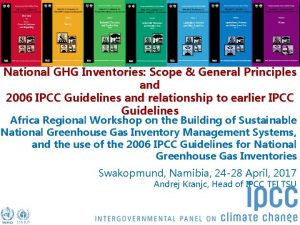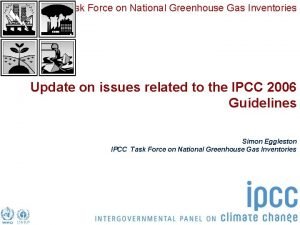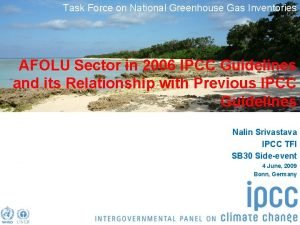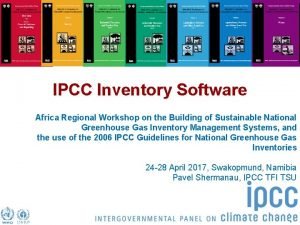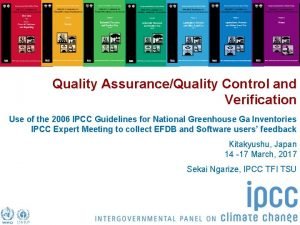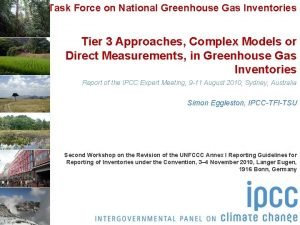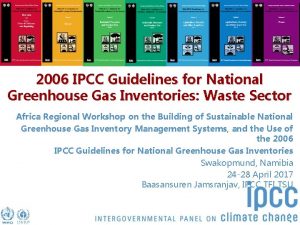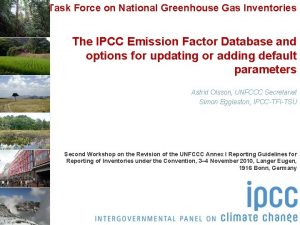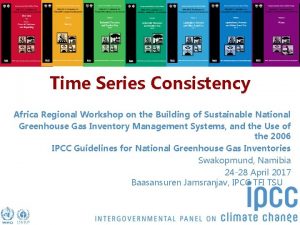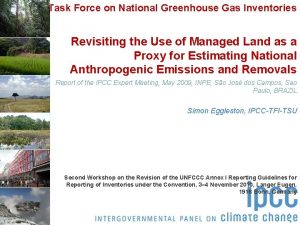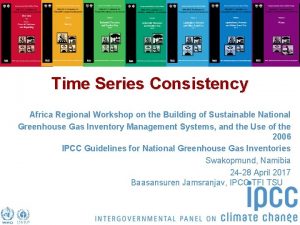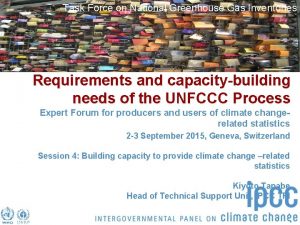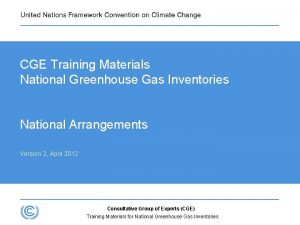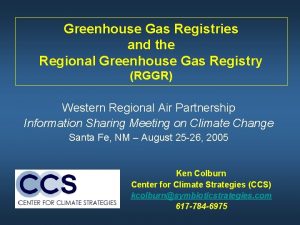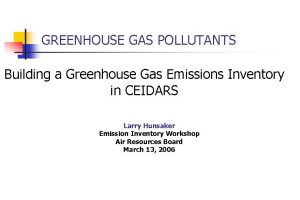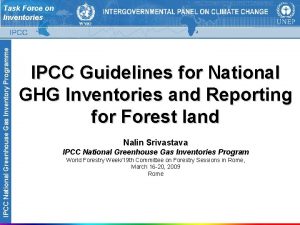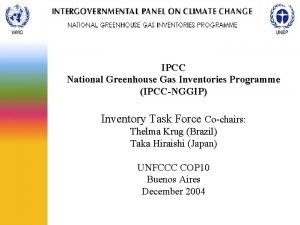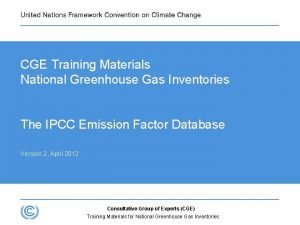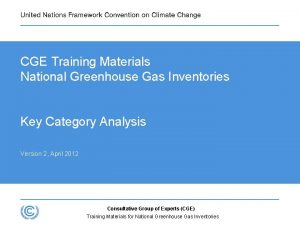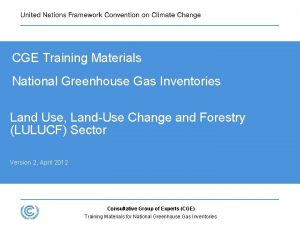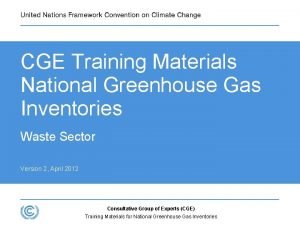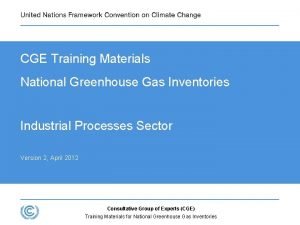Task Force on National Greenhouse Gas Inventories National




























- Slides: 28

Task Force on National Greenhouse Gas Inventories National GHG Inventories: Scope & General Principles and 2006 IPCC Guidelines and relationship to earlier IPCC Guidelines Africa Regional Workshop on the Building of Sustainable National Greenhouse Gas Inventory Management Systems, and the use of the 2006 IPCC Guidelines for National Greenhouse Gas Inventories Swakopmund, Namibia, 24 -28 April, 2017 Task Force on National Greenhouse Gas Inventories Andrej Kranjc, Head of IPCC TFI TSU

What are national GHG inventories? • Estimates of all emissions (and removals) of particular gases from given sources from a defined region in a specific period of time • Here we are dealing with – Greenhouse Gases – National Estimates – Annual Estimates

Why? • Scientific Understanding – Input to models – Understand link between environmental pollution and effects to sources of pollution • Policy – Before any pollution problem can be efficiently controlled we need to know the sources and amounts emitted – To help develop cost-effective policy – To monitor progress towards policy goals – To inform the public

DPSIR DRIVERS e. g. Industry & transport PRESSURES e. g. emissions STATE e. g. ambient concentrations IMPACT e. g. temperature, sea level, storm intensity RESPONSES e. g. Adaptation and Mitigation – sea defences, public transport, emission controls, fuel switching

Why do we need inventory guidelines? • Any international agreement to limit climate change must set emission limits/targets/aims and monitor progress in an open and transparent way • Currently, most national emissions can only be estimated, not measured and so we need a consensus on the best way of doing this. ― Cannot measure all sources (e. g. road transport would be impractical; Remote sensing techniques not available) • To do this we need reliable, generally accepted methods and guidelines

How? • Make estimates based on parameters associated with emission rates – CO 2 from fuel depends on carbon in fuel – CO 2 proportional to amount of fuel burnt – Changes on stocks of carbon in forests give emissions (or removals) of CO 2 Where: E = Emission EF = Emission Factor AD = Activity Data

Credibility • As these are estimates we need to ensure they are credible • Verification – Checking that the numbers are correct – that they reflect the true emissions • Validation – Checking that the estimates are compiled correctly in the way they are supposed to be done – Needs standard methodologies and inventory management

Good Practice (1) • Assists countries in producing inventories that are accurate in the sense of being neither over- nor underestimates so far as can be judged, and in which uncertainties are reduced as far as possible – Gives a way to manage uncertainties – Identifies main “KEY” categories to focus resources – Documentation provides

Good Practice (2) • IPCC Good Practice gives guidance on – Approaches to Data Collection – Uncertainty Evaluations – Key Category Analysis and Methodological Choice – Recalculations – Quality Control and Quality Assurance – Review – Documentation

Good Practice (3) • Supports the development of inventories that are: – – – – Transparent Documented Consistent over time Complete Comparable Assessed for uncertainties Subject to quality control and assurance Efficient in the use of resources available to inventory agencies – In which uncertainties are gradually reduced as better information becomes available

Evolution • • • Guidelines have evolved from 1996 to 2006 Development of Good Practice Guidance (GPG) was a major step forward – Complete, consistent, comparable, transparent, and accurate inventories taking account of available resources – Major change was from 1996 LUCF to GPG LULUCF 2006 Guidelines [2. 5 years work, 250 authors] – Have 4 sectors – Have improved methods and default data – Cover more greenhouse gases and methods – Integrate GPG – Require similar resources – Do not pre-empt accounting choices – The best globally applicable methods 2013 +

IPCC Inventory Guidelines Non-Annex I Parties should use 1996 Guidelines. (Annex to Decision 17/CP. 8) 1995 IPCC Guideline s New Supplementary Guidance in 2013 + Non-Annex I Parties are encouraged to use GPGs. GPG 2000 (non. LULUCF) GPG 200 3 Annex I Parties must use from 2015 (LULUCF) Revised 1996 IPCC Guidelines Actually, 2006 Guidelines are being used by more and more Non-Annex I Parties. Revision/Update by the IPCC 2006 IPCC Guideline s

2006 Guidelines being used by NAI Parties • At the 42 nd Session held in June 2015, the Subsidiary Body for Implementation (SBI) of the UNFCCC concluded under the agenda item on “Reporting from Parties not included in Annex I to the Convention”: ― “The SBI noted the requests from non. Annex I Parties for further technical support aimed at improving their domestic capacity to facilitate continuity in meeting reporting requirements through training on the use of the 2006 IPCC Guidelines for National Greenhouse Gas Inventories, …” (FCCC/SBI/2015/10, paragraph 29)

Methodological approaches unchanged Ø In General: Ø Energy • Based on carbon content of fuel • Fugitive (leaks) use emission factors Ø Industrial Processes • Based on chemistry of process • Some use mass balance of product used Ø Land Use • Stock changes ⇒ Emissions/Removals 1. Inputs (e. g. growth) - outputs (e. g. decay, harvest) 2. Total Stock at end minus Total stock at beginning Ø Agriculture • Based on understanding of processes Ø Waste • Tracks carbon (fossil & biogenic) in waste

GPG and Sectoral Guidance • Good Practice inventories are defined as “those that contain • GPG retains consistency with Revised 1996 Guidelines and is updated and expanded in the 2006 Guidelines neither over- nor under-estimates so far as can be judged, and in which uncertainties are reduced as far as is practical” – Approaches to Data Collection 15

Guidelines – Sources Identified in 2006 Guidelines By-product & fugitive emissions Halogenated Compounds Production GWP in TAR GWP in AR 4 ✔ ✔ ✔ ✔ CF 3 I, CH 2 Br 2, CHCl 3 ✔ ✔ ✔ CH 2 Cl 2, CH 3 Cl ✔ ✔ ✔ Magnesium production ✔ Electronics Industries ✔ nitrogen trifluoride (NF 3) ✔ trifluoromethyl sulphur pentafluoride (SF 5 CF 3) halogenated ethers (e. g. C 4 F 9 OC 2 H 5, CHF 2 OC 2 F 4 OCHF 2, CHF 2 OCHF 2) ✔ C 3 F 7 C(O)C 2 F 5 16 C 4 F 6, C 5 F 8, c-C 4 F 8 O ✔ ✔

Direct & Indirect Emissions: CO 2 and N 2 O 2006 Guidelines “CO 2 Emissions” do not include this automatically 2006 Guidelines includes ALL NH 3 & NOx Emissions 2006 Guidelines give methods to calculate this

Estimation of Actual Annual Emissions • In the 1996 Guidelines and Good Practice Guidance for a few sources, the simplest methodology estimates a “potential emission” rather than the actual annual emission. – This “potential emission” assumes all the emissions from an activity occur in the current year, ignoring the fact they will occur over many years (e. g. methane emissions from waste in landfills occurs over decades as the decay processes take place). • In the 2006 Guidelines, simple default methods estimate emissions when they occur, thus removing the need for potential emissions. • The removal of potential emission estimates also allows the emission reductions of abatement techniques to be properly estimated and ensures that the Tier 1 methods are compatible with higher tier methods. The areas where this occurred are: – Actual emissions of fluorinated compounds

“New” Guidance in 2006 Guidelines

New Methodology Reports • The TFI has developed two additional methodology reports in response to the invitations from UNFCCC: ― 2013 Supplement to the 2006 IPCC Guidelines for National Greenhouse Gas Inventories: Wetlands (Wetlands Supplement) • ― To fill gaps in the coverage of wetlands and organic soils in the 2006 IPCC Guidelines 2013 Revised Supplementary Methods and Good Practice Guidance Arising from the Kyoto Protocol (KP Supplement) • To update and augment the existing Chapter 4 of the GPGLULUCF • The Wetlands Supplement and KP Supplement were adopted/accepted by the IPCC Plenary at its 37 th Session (IPCC 37) in Batumi, Georgia, 14 -18 October 2013, and http: //www. ipccpublished on the TFI website in February 2014. nggip. iges. or. jp/public/wetlands/index. html • Wetlands Supplement http: //www. ipcc-

2019 Refinement to the 2006 IPCC Guidelines (1) ØTFB at its 26 th Meeting in Ottawa (28 -29 August 2014) concluded that: § 2006 IPCC Guidelines provide a technically sound methodological basis of national greenhouse gas inventories; however, § to maintain their scientific validity, certain refinements may be required, taking into account scientific and other technical advances that have matured

2019 Refinement to the 2006 IPCC Guidelines (2) ØIPCC decided at its 44 th session in Bangkok on 17 -20 October 2016 to prepare a Methodology Report to refine the 2006 IPCC Guidelines with the following format and title: § The format should be one single Methodology Report comprising an Overview Chapter and five volumes following the format of the 2006 IPCC Guidelines for National Greenhouse Gas Inventories (2006 IPCC Guidelines). § The title of the Methodology Report should

2019 Refinement to the 2006 IPCC Guidelines (3) ØWill be completed in May 2019. ØAim: o to provide an updated and sound scientific basis for supporting the preparation and continuous improvement of national GHG inventories; o not to revise the 2006 IPCC Guidelines, but update, supplement and/or elaborate the 2006 IPCC Guidelines where gaps or out-of-date science have been identified. ØFormat and Structure: o Same as the 2006 IPCC Guidelines (= Overview Chapter and 5 Volumes) so as to make it easier for inventory compilers toreplace use the 2019 IPCC Refinement The 2019 Refinement will not the 2006 Guidelines. in the 2006 Guidelines. Itconjunction should be usedwith in conjunction with. IPCC the 2006 IPCC Guidelines.

2019 Refinement to the 2006 IPCC Guidelines (4) Ø To be developed by approximately 200 authors from all over the world. Ø Three review stages are planned: u. Expert Review of First Order Draft: Dec 2017 – Feb 2018 u. Government/Expert Review of Second Order Draft: Jul – Sep 2018 u. Government Review of Final Draft: Jan – Mar 2019 Ø Scope and outline approved by the IPCC at its 44 th Session (Oct 2016, Bangkok, Thailand) are included in Decision IPCC/XLIV-5. u http: //www. ipcc. ch/meetings/session 44/p 44_decisions. pdf Ø Other relevant documents: u Report of the Scoping Meeting (Aug 2016, Minsk, Belarus) http: //www. ipcc-nggip. iges. or. jp/meeting. html u Presentations at a side event during COP-22 (Nov 2016, Marrakech, Morocco)

Various Tools – Supporting Materials • Emission Factor Database (EFDB) http: //www. ipccnggip. iges. or. jp/EFDB/ • IPCC Inventory Software http: //www. ipccnggip. iges. or. jp/software/index. html • Primer for 2006 IPCC Guidelines http: //www. ipccnggip. iges. or. jp/support. html • Reports of Expert Meetings http: //www. ipccnggip. iges. or. jp/meeting. html

Various Tools – FAQ Website • Answers to frequently asked questions (FAQs) such as: § Q 1 -3 -2: “What is the difference between accuracy and precision? Does uncertainty assessment relate to both? ” § Q 2 -10: “According to the IPCC Guidelines CO 2 Emissions from the combustion of biomass are reported as zero in the Energy sector. Do the IPCC Guidelines consider biomass used for energy to be carbon neutral? ” v. Continuously updated § For example, a new set of Q&As on the use of 2006 http: //www. ipcc. Guidelines in other areas has been recently added following a relevant expert meeting. nggip. iges. or. jp/faq. html

Summary ü Emission inventories have several uses. Ø They help understand problems and are a key to policy development as well as reporting and monitoring progress towards targets. ü They are estimates and cannot be completely measured. ü Inventory management and “good practice” is as important as the emission estimation itself. ü The same basic methodological approaches are used from 1996 Guidelines, through GPG 2000 & GPG LULUCF to 2006 Guidelines. ü The 2006 Guidelines maintain, with improvements, the methods of earlier guidelines and integrate GPG. ü The 2006 Guidelines provide improved guidance in some areas, more and improved default data. Ø Wider coverage of gases Ø Additional sources covered Ø All estimates are now of actual annual emissions (“potential” emissions not needed) Ø Categories simplified and clarified in some areas

Task Force on National Greenhouse Gas Inventories Thank you!
 Which of the following is not a greenhouse gas?
Which of the following is not a greenhouse gas? Informal and formal reading assessments
Informal and formal reading assessments Accounting chapter 6
Accounting chapter 6 Recycled inventories in housekeeping
Recycled inventories in housekeeping Chapter 8 inventories and the cost of goods sold
Chapter 8 inventories and the cost of goods sold Mnemjian inventories
Mnemjian inventories Juloidian inventories
Juloidian inventories 6 functions of inventory
6 functions of inventory Principles of accounting chapter 6 answers
Principles of accounting chapter 6 answers Chapter 9 inventories additional valuation issues
Chapter 9 inventories additional valuation issues Cost of good sold formula
Cost of good sold formula Intercompany journal entries
Intercompany journal entries Lower of cost or market
Lower of cost or market Dollar value lifo
Dollar value lifo Intercompany transactions journal entries
Intercompany transactions journal entries Smarter inventories
Smarter inventories Chapter 6 inventories
Chapter 6 inventories Tiered task bias task
Tiered task bias task Nwcg s-330
Nwcg s-330 Friendly armor battalion task force symbol jko
Friendly armor battalion task force symbol jko Glencoe sustainability task force
Glencoe sustainability task force R.e.a.c.t. task force
R.e.a.c.t. task force Www.youtube.com
Www.youtube.com Fatf 40 recommendations
Fatf 40 recommendations Green ribbon task force
Green ribbon task force Princeton policy task force
Princeton policy task force Desktop management task force
Desktop management task force Anchor institutions task force
Anchor institutions task force Global harmonization task force
Global harmonization task force
